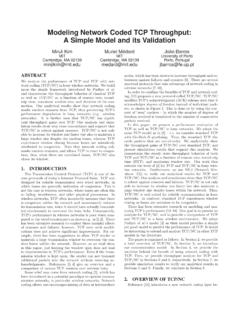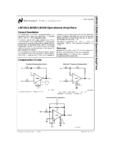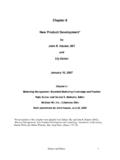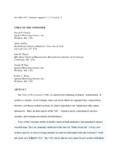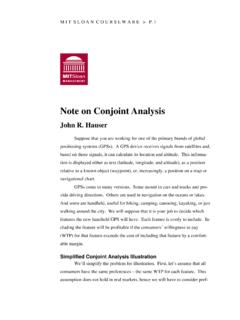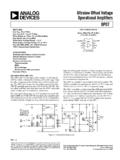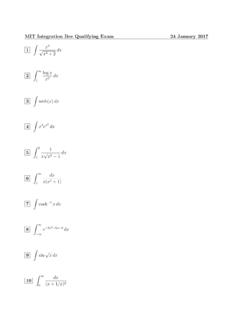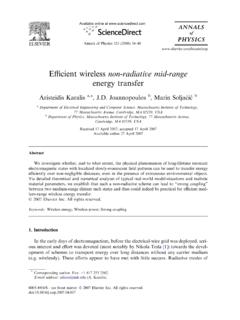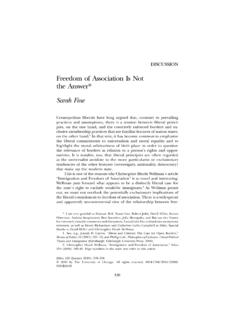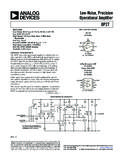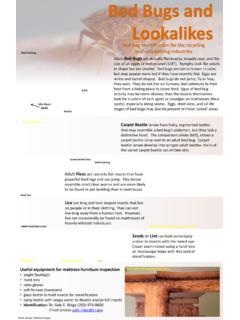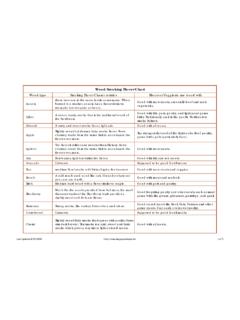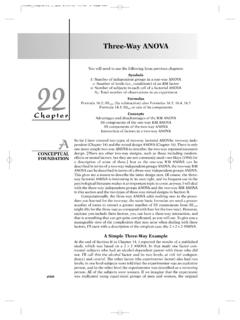Transcription of Theory and applications of Robust Optimization - …
1 Theory and applications of Robust Optimization Dimitris Bertsimas , David B. Brown , Constantine Caramanis . July 6, 2007. Abstract In this paper we survey the primary research, both theoretical and applied, in the field of Robust Optimization (RO). Our focus will be on the computational attractiveness of RO approaches, as well as the modeling power and broad applicability of the methodology. In addition to surveying the most prominent theoretical results of RO over the past decade, we will also present some recent results linking RO to adaptable models for multi-stage decision-making problems. Finally, we will highlight successful applications of RO across a wide spectrum of domains, including, but not limited to, finance, statistics, learning, and engineering. Keywords: Robust Optimization , robustness, adaptable Optimization , applications of Robust Op- timization. 1 Introduction Optimization affected by parameter uncertainty has long been a focus of the mathematical programming community.
2 Indeed, it has long been known (and recently demonstrated in compelling fashion in [15]) that solutions to Optimization problems can exhibit remarkable sensitivity to perturbations in the parameters of the problem, thus often rendering a computed solution highly infeasible, suboptimal, or both (in short, potentially worthless). Stochastic Optimization starts by assuming the uncertainty has a probabilistic description. This approach has a long and active history dating at least as far back as Dantzig's original paper [44]. We refer the interested reader to several textbooks ([64, 31, 87, 66]) and the many references therein for a more comprehensive picture of Stochastic Optimization . This paper considers Robust Optimization (RO), a more recent approach to Optimization under uncertainty, in which the uncertainty model is not stochastic, but rather deterministic and set-based.. Boeing Professor of Operations Research, Sloan School of Management and Operations Research Center, Massachusetts Institute of Technology, E40-147, Cambridge, MA 02139.
3 Assistant Professor of Decision Sciences, 1 Towerview Drive, Fuqua School of Business, Duke University, Durham, NC. 27705.. Assistant Professor, Department of Electrical and Computer Engineering, The University of Texas at Austin, 1 University Station, Austin, TX 78712. 1. Instead of seeking to immunize the solution in some probabilistic sense to stochastic uncertainty, here the decision-maker constructs a solution that is optimal for any realization of the uncertainty in a given set. The motivation for this approach is twofold. First, the model of set-based uncertainty is interesting in its own right, and in many applications is the most appropriate notion of parameter uncertainty. Next, computational tractability is also a primary motivation and goal. It is this latter objective that has largely influenced the theoretical trajectory of Robust Optimization , and, more recently, has been responsible for its burgeoning success in a broad variety of application areas.
4 In the early 1970s, Soyster [92] was one of the first researchers to investigate explicit approaches to Robust Optimization . This short note focused on Robust linear Optimization in the case where the column vectors of the constraint matrix were constrained to belong to ellipsoidal uncertainty sets; Falk [50]. followed this a few years later with more work on inexact linear programs. The Optimization community, however, was relatively quiet on the issue of robustness until the work of Ben-Tal and Nemirovski ( , [13, 14, 15]) and El Ghaoui et al. [56, 58] in the late 1990s. This work, coupled with advances in computing technology and the development of fast, interior point methods for convex Optimization , particularly for semidefinite Optimization ( , Boyd and Vandenberghe, [34]) sparked a massive flurry of interest in the field of Robust Optimization . Central issues we seek to address in this paper include: 1.
5 Tractability of Robust Optimization models: In particular, given a class of nominal problems ( , LP, SOCP, SDP, etc.) and a structured uncertainty set (polyhedral, ellipsoidal, etc.), what is the complexity class of the corresponding Robust problem? 2. Conservativeness and probability guarantees: How much flexibility does the designer have in se- lecting the uncertainty sets? What guidance does he have for this selection? And what do these uncertainty sets tell us about probabilistic feasibility guarantees under various distributions for the uncertain parameters? 3. Flexibility, applicability, and modeling power: What uncertainty sets are appropriate for a given application? How fragile are the tractability results? For what applications is this general method- ology suitable? As a preview of what is to come, we give (abdridged) answers to the three issues raised above. 1. Tractability: In general, the Robust version of a tractable Optimization problem may not itself be tractable.
6 In this paper we outline tractability results, which depend on the structure of the nominal problem as well as the class of uncertainty set. Many well-known classes of Optimization problems, including LP, QCQP, SOCP, SDP, and some discrete problems as well, have a RO formulation that is tractable. 2. Conservativeness and probability guarantees: RO constructs solutions that are deterministically immune to realizations of the uncertain parameters in certain sets. This approach may be the 2. only reasonable alternative when the parameter uncertainty is not stochastic, or if no distributional information is available. But even if there is an underlying distribution, the tractability benefits of the Robust Optimization paradigm may make it more attractive than alternative approaches from Stochastic Optimization . In this case, we might ask for probabilistic guarantees for the Robust so- lution that can be computed a priori, as a function of the structure and size of the uncertainty set.
7 In the sequel, we show that there are several convenient, efficient, and well-motivated parameteriza- tions of different classes of uncertainty sets, that provide a notion of a budget of uncertainty. This allows the designer a level of flexibility in choosing the tradeoff between robustness and performance, and also allows the ability to choose the corresponding level of probabilistic protection. 3. Flexibility and modeling power: In Section 2, we survey a wide array of Optimization classes, and also uncertainty sets, and consider the properties of the Robust versions. In the final section of this paper, we illustrate the broad modeling power of Robust Optimization by presenting a broad variety of applications . The overall aim of this paper is to outline the development and main aspects of Robust Optimization , with an emphasis on its power, flexibility, and structure. We will also highlight some exciting and important open directions of current research, as well as the broad applicability of RO.
8 Section 2 focuses on the structure and tractability of the main results, describing when, where, and how Robust Optimization is applicable. Section 3 describes important new directions in Robust Optimization , in particular multi- stage adaptable Robust Optimization , which is much less developed, and rich with open questions. In Section 4, we detail a wide spectrum of application areas to illustrate the broad impact that Robust Optimization has had in the early part of its development. 2 Structure and tractability results In this section, we outline several of the structural properties, and detail some tractability results of Robust Optimization . We also show how the notion of a budget of uncertainty enters into several different uncertainty set formulations, and we present some a priori probabilistic feasibility and optimality guarantees for solutions to Robust Optimization problems. Robust Optimization The general Robust Optimization formulation is: minimize f0 (x).
9 Subject to fi (x, ui ) 0, ui Ui , i = 1, .. , m. ( ). Here x Rn is a vector of decision variables, f0 , fi are as before, ui Rk are disturbance vectors or parameter uncertainties, and Ui Rk are uncertainty sets, which, for our purposes, will always be closed. 3. Note that by introducing a new constraint if necessary, we can always take the objective function to have no uncertainty. The goal of ( ) is to compute minimum cost solutions x among all those solutions which are feasible for all realizations of the disturbances ui within Ui . If Ui is a singleton, then the corresponding constraint has no uncertainty. Intuitively, this problem offers some measure of feasibility protection for Optimization problems containing parameters which are not known exactly. It is worthwhile to notice the following, straightforward facts about the problem statement of ( ): We can assume without loss of generality that the uncertainty set U has the form U = U1.
10 Um , due to the constraint-wise feasibility requirements (see also Ben-Tal and Nemirovski, [14]). Problem ( ) also contains the instances when the decision or disturbance vectors are contained in more general vector spaces than Rn or Rk , such as Sn in the case of semidefinite Optimization . We emphasize that Robust Optimization is distinctly different than sensitivity analysis, which is typically applied as a post- Optimization tool for quantifying the change in cost for small perturbations in the underlying problem data. Here, our goal is to compute solutions with a priori ensured feasibility when the problem parameters vary within the prescribed uncertainty set. We refer the reader to some of the standard Optimization literature ( , Bertsimas and Tsitsiklis, [29], Boyd and Vandenberghe, [35]). and works on perturbation Theory ( , Freund, [53], Renegar, [88]) for more on sensitivity analysis.
